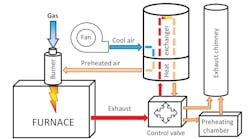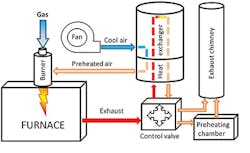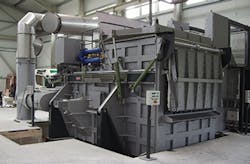Aluminum foundries and diecasters have incentives to increase the energy efficiency of their melting processes, meaning both opportunities for operating cost savings and obligations for regulatory compliance. Burner-air preheating by means of a heat exchanger will reduce significantly a furnace’s gas consumption, and increasing the flame temperature will reduce the melting-process time and repurpose exhaust heat, with positive environmental effects.
In 2016, the prototype of an optimized aluminum melting system was realized as part of a German Federal Ministry of Economics and Technology (BMWi)-funded co-op project, between the industrial and business communities. The results of the Edusal II project make it possible to determine the energy-saving potential of melting, and at the same time maximize melting productivity.
In burner air preheating by means of a heat exchanger, the warm exhaust-gas volume flow is directed via a suitable pipe system to a heat exchanger. This saves on gas consumption.
ZPF GmbH is a developer of aluminum-melting process technologies and a designer and manufacture of high-efficiency furnaces for aluminum melting, chip melting, and holding furnaces. In an earlier adaptation of the Edusal II project results, ZPF researchers showed how monitoring the charge material can indicate more efficient orientation of burners in the furnace.
Heat exchanger — In order to reduce gas consumption in such a system even further, and thus to increase both energy efficiency and resource conservation, furnace manufacturer ZPF extended its concept with additional components: By incorporating a burner-air preheating system in which the warm exhaust gas volume flow is passed through a pipe system to a heat exchanger, the system operator is able to achieve lower pollutant emissions and lower gas consumption. With appropriate adjustments, this new system can be used as a retrofit kit for existing ZPF melting systems, the developer reported.
"In the initial project, numerous sustainable improvements that have optimized the previous furnace system were achieved," said Sven-Olaf Sauke, head of R&D at ZPF. "The main focus was on the further development of the measurement technology to a sensory detection of the melting shaft, which means that in laboratory operation both the position of the residual material on the melting link and its quantity can be precisely determined.
“In addition, a special evaluation algorithm has been developed that has improved the process to the point that an increase in melting efficiency of up to 15% can be achieved."
Another focus of the Edusal II system was testing of burner-air preheating. The idea of integrating a burner-air preheating that efficiently uses the heat flow of the system has been around for a long time. However, because solutions with partly impractical characteristics and are offered on the market, an electrical preheating was initially installed. This allows very precise control of fuel consumption, and thus also to balance the profitability of the fuel volume. The characteristic values obtained were used to design a burner-air preheating from the exhaust-gas stream of the melting system.
"With this version, the already heated exhaust-gas flow is directed to a heat exchanger via a suitable pipe system," Sauke continued.
Handling gas carefully — The primary air (hot gas) side of the system, which is prefixed to the heat exchanger, requires additional components. For example, a control unit that directs the exhaust-gas flow to the heat exchanger as required, and additional measuring points that ensure safe process management.
In the event of failure of the heat exchanger or any of the components, the control unit must direct the exhaust flow through a bypass function, past the heat exchanger, directly into the secondary system to protect the heat exchanger and its components. In the heat exchanger, the energy is released to the secondary air (burner air) side; the cooled exhaust gas is discharged in the other system either directly into the atmosphere, or to preheat the furnace charge material in a corresponding chamber.
The burner-air fan conveys cold burner air from the environment into the heat exchanger, which is heated there in the ZPF melting system to about 200° C. The pipe system after the heat exchanger is insulated and equipped with appropriate butterfly valves, measuring instruments and displays. An air collector installed directly after the heat exchanger helps distribute the heated medium evenly across the piping to the entire burner system. Thus, the flame temperature increases significantly, resulting in a higher energy input and lower gas consumption.
This furnace shows the electrical version
of the ZPF burner-air preheating system - without heat exchanger. For operating
cost reasons, however, the variant with a heat exchanger is recommended.
"In this way, not only are operating and energy costs reduced, the system also allows for a careful handling of the valuable resource of gas," said Sauke. "The efficiency of the entire system is increased, and the pollutant emissions are reduced."
This heat exchanger variant is suitable for all ZPF gas-fired aluminum melting and holding furnaces, which have a connected load of more than 300 kW and a high melting rate over the entire operating sequence of the furnace. However, the specified temperature limits for furnace refractory lining must be strictly maintained.
Retrofitting burner-air preheating — The extension of energy-efficient burner-air preheating with an integrated heat exchanger also can be carried out with an existing melting system, but requires some changes, according to Sauke.
"When upgrading existing ZPF systems, in addition to the heat exchanger, hot-gas withdrawal point-suitable piping and temperature-resistant control and butterfly valves must be integrated. The adjustments must be made with regard to the control as well as the user interface."
All electrically operated components, for example the control valves and the measuring technology, are integrated in the control and in the control cabinet, in order to simplify the operation of the system, he noted. All modifications and retrofits of the system are done by ZPF at a customer's premises, following a comprehensive inventory, consultation, and an in-depth evaluation.
"The need for pipes, routes, and insulation material must be calculated on a project-specific basis,” Sauke explained. “The advantage of the developed system lies in the fact that all components are installed directly at the plant, and thus no further space requirement arises in the melting system.”
ZPF is continuing to research and develop measures to improve the efficiency of the aluminum melting systems.











